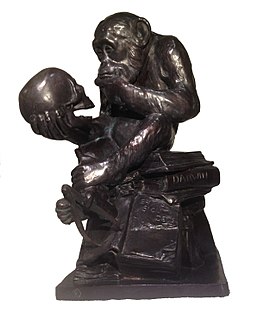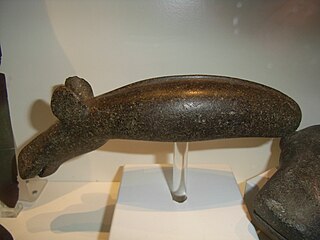 W
WThe Affe mit Schädel is a famous work by the late-19th-century German sculptor Hugo Rheinhold. The statuette is otherwise known as the Affe, einen Schädel betrachtend. It was first exhibited in 1893 at the Große Berliner Kunstaustellung.
 W
WThe Alunda moose or the Alunda axe is a Neolithic stone axe c.2000 B.C.that was found during the excavation of a ditch in Norrlövsta i Alunda parish, Östhammar Municipality, Uppland in 1920. The Alunda moose is considered one of the most beautiful animal sculptures of the Nordic neolithic and is a 21 cm. ceremonial axe carved from greenish black diorite. One side is shaped like a moose head. The sculpture was realized in a naturalistic and elegant manner. The axe has a shaft hole but only had a symbolic function since the hole is not completely bored through and the axe hasn't been used in battle. The axe may originate from Karelia where similar animal depictions are known. It is displayed in the Swedish History Museum.
 W
WThe Big Elk, also known as Storelgen, is the world's second-tallest sculpture of a moose. Moose are often called elk in Europe. It is near the village of Atna in Stor-Elvdal, Hedmark, Norway. It held the title of the tallest moose sculpture for 4 years, from its completion in October 2015 until October 2019.
 W
WThe two fontane dei mostri marini are located in the Santissima Annunziata plaza in Florence.
 W
WThe Friendship Fountain, also known as Dancing Dolphins, is a 1987 sculpture depicting three dolphins by James "Bud" Bottoms and Octavio González, installed along Puerto Vallarta's Malecón, in the Mexican state of Jalisco.
 W
WAccording to the Bible, the golden calf was an idol made by the Israelites when Moses went up to Mount Sinai. In Hebrew, the incident is known as ḥēṭ’ ha‘ēggel or the Sin of the Calf. It is first mentioned in the Book of Exodus.
 W
WHow Doth the Little Crocodile is both a painting and an outdoor bronze sculpture by British-born Mexican surrealist artist Leonora Carrington.
 W
WMaría Lionza is a large statue depicting the titular goddess, María Lionza, riding a tapir. It is located between lanes of the Francisco Fajardo freeway next to the University City campus of the Central University of Venezuela, in Caracas. The original, which is currently located in a university warehouse, was created by Alejandro Colina in 1951 to sit outside the stadium for that year's Bolivarian Games. In its place on the highway is a cast made by Silvestre Chacón in 2004; the replacement has received negative reactions, and its construction damaged the original.
 W
WThe Monument to the laboratory mouse is a sculpture in Novosibirsk' Akademgorodok, Siberia, Russia. It is located in a park in front of the Institute of Cytology and Genetics of the Russian Academy of Sciences, and was completed on July 1, 2013, coinciding with the 120th anniversary of the founding of the city.
 W
WThe Monumento al perro callejero, also known as Peluso, is an outdoor bronze sculpture installed along Insurgentes Sur Avenue, in the southern borough of Tlalpan, in Mexico City. The statue was unveiled in July 2008 and was dedicated to the free-ranging dogs of the city.
 W
WRabbit is a 1986 series of three identical stainless steel sculptures by Jeff Koons. One of the editions of Rabbit is the most expensive work sold by a living artist at auction, being sold for $91.1 million in May 2019.
 W
WThe Ram in a Thicket is a pair of figures excavated in Ur, in southern Iraq, which date from about 2600–2400 BC. One is in the Mesopotamia Gallery in Room 56 of the British Museum in London; the other is in the University of Pennsylvania Museum in Philadelphia, USA.
 W
WSalmon Cycle Marker is a 2005 sculpture by Ken MacKintosh and Lillian Pitt, installed outside Portland State University's Native American Student and Community Center, in the U.S. state of Oregon.
 W
WThe Statue of the Bear and the Strawberry Tree is a sculpture from the second half of the 20th century, situated in the Spanish city of Madrid. It represents the coat of arms of Madrid and is found on the east side of the Puerta del Sol, between Calle de Alcalá and Carrera de San Jerónimo, in the historical centre of the capital.
 W
WThe Boy on the Seahorse, commonly known as El caballito, is a sculpture by Rafael Zamarripa. Two versions are installed in Puerto Vallarta, in the Mexican state of Jalisco; one along the Malecón in Centro and another at Playa de los Muertos in Zona Romántica.
 W
WGyörgy Vastagh was a Hungarian sculptor. His works are in traditional Romantic and Classical styles. Most of them are monuments or memorials, although he is also known for sculptures of animals.